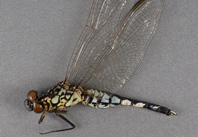Abstract
The dragonfly genus Acisoma is revised based on adult male morphology and COI sequence data. Six species are recognised, including the new species A. attenboroughi sp. nov. Diagnoses and a key to males of all species and illustrations of all relevant characters are provided. A. inflatum, A. variegatum and A. trifidum are confined to continental Africa, while A. panorpoides is restricted to Asia. A. ascalaphoides is known only from threatened littoral forest fragments on the east coast of Madagascar, while A. attenboroughi is widespread across the island. The new species honours Sir David Attenborough on his 90th birthday.
References
Aberer, A.J., Kobert, K. & Stamatakis, A. (2014) ExaBayes: Massively parallel Bayesian tree inference for the whole-genome era. Molecular Biology and Evolution, 31, 2553–2556.
http://dx.doi.org/10.1093/molbev/msu236Clausnitzer, V., Dijkstra, K.-D.B., Koch, R., Boudot, J.-P., Darwall, W.R., Kipping, J., Samraoui, B., Samways, M.J., Simaika, J.P. & Suhling, F. (2012) Focus on African freshwaters: hotspots of dragonfly diversity and conservation concern. Frontiers in Ecology and the Environment, 10, 129–134.
http://dx.doi.org/10.1890/110247Consiglio, T., Schatz, G.E., McPherson, G., Lowry II, P.P., Rabenantoandro, J., Rogers, Z.S., Rabevohitra, R. & Rabehevitra D. (2006) Deforestation and plant diversity of Madagascar’s littoral forests. Conservation Biology, 20, 1799–1803.
http://dx.doi.org/10.1111/j.1523-1739.2006.00562.xDijkstra, K.D.B. (2016) Restore our sense of species. Nature, 533 (7602). [in press]
Dijkstra K.-D.B. & Clausnitzer V. (2014) The dragonflies and damselflies of eastern Africa: handbook for all Odonata from Sudan to Zimbabwe. Studies in Afrotropical Zoology, 298, 1–260.
Dijkstra, K.-D.B., Bechly, G., Bybee, S.M., Dow, R.A., Dumont, H.J., Fleck, G., Garrison, R.W., Hämäläinen, M., Kalkman, V.J., Karube, H., May, M.L., Orr, A.G., Paulson, D., Rehn, A.C., Theischinger, G., Trueman, J.W.H., van Tol, J., von Ellenrieder N. & Ware, J. (2013) The classification and diversity of dragonflies and damselflies (Odonata). In: Zhang, Z.-Q. (Ed.), Animal biodiversity: An outline of higher-level classification and survey of taxonomic richness. Zootaxa, 3730, 36–45.
http://dx.doi.org/10.11646/zootaxa.3703.1.9
Dijkstra, K.-D. B., Kalkman, V.J., Dow, R.A., Stokvis, F.R. & van Tol, J. (2014) Redefining the damselfly families: a comprehensive molecular phylogeny of Zygoptera (Odonata). Systematic Entomology, 39, 68–96.
http://dx.doi.org/10.1111/syen.12035Dijkstra, K.-D.B., Kipping, J. & Mézière, N. (2015) Sixty new dragonfly and damselfly species from Africa (Odonata). Odonatologica, 44, 447–678.
http://www.osmylus.com/images/own/Downloads/Odonatologica_44-4-low_res.pdf
Folmer, O., Black, M., Hoeh, W., Lutz, R. & Vrijenhoek, R. (1994) DNA primers for amplification of mitochondrial cytochrome coxidase subunit I from diverse metazoan invertebrates. Molecular Marine Biology and Biotechnology, 3 (5), 294–299
Hebert, P.D.N., Penton, E.H., Burns, J.M., Janzen, D.H. & Hallwachs, W. (2004) Ten species in one: DNA barcoding reveals cryptic species in the neotropical skipper butterfly Astraptes fulgerator. Proceedings of the National Academy of Sciences
of the United States of America, 101 (41), 14812–14817.
http://dx.doi.org/10.1073/pnas.0406166101
Katoh, K., Asimenos, G. & Toh, H. (2009) Multiple alignment of DNA sequences with MAFFT. Methods in Molecular Biology, 537, 39–64.
http://dx.doi.org/10.1007/978-1-59745-251-9_3Kirby, W.F. (1889) A revision of the subfamily Libellulinae, with descriptions of new genera and species. Proceedings of the Zoological Society of London, 12 (9), 249–348.
Kirby, W.F. (1898) On a collection of dragonflies from the Transvaal and Nyasaland. Annals & Magazine of Natural History, 2 (7), 229–245.
http://dx.doi.org/10.1080/00222939808678038Larsson, A. (2014) AliView: a fast and lightweight alignment viewer and editor for large data sets. Bioinformatics, 30, 3276–3278.
http://dx.doi.org/10.1093/bioinformatics/btu531Martin, R. (1905) Odonates de Grand-Bassam. Bulletin Jardin Colonial Jardins essai Colonies, 23, 174–176.
Pinto, Â.P. (2013) A cladistics analysis of Sympetrinae Tillyard, 1917 with an emphasis in the group of specialized femoral armature: the genera of ‘Erythemismorpha’ (Insecta: Odonata: Libellulidae). PhD thesis, São Paulo.
Rambur, J.P. (1842) Histoire naturelle des insectes: Névroptères. Librairie Encyclopédique de Roret, Paris.
Rambaut, A. (2014) FigTree. Available at http://tree.bio.ed.ac.uk/software/figtree/
Ratnasingham, S. & Hebert, P.D.N. (2007) BOLD: the barcode of life data system (www.barcodinglife.org). Molecular Ecology Notes, 7, 55–364.
http://dx.doi.org/10.1111/j.1471-8286.2007.01678.xRis, F. (1911) Libellulinen monographisch bearbeitet, Vol. II. Libellulinen 5. Collections Zoologiques du Baron Edm. de Selys Longchamps. Catalogue Systématique et Descriptif, 13, 455–460.
Schütte, K. & Razafindraibe, P. (2007) Checklist of dragonflies of the littoral forests near Tolagnaro (Fort Dauphin). In: Ganzhorn J.U., Goodman, S.M., Vincelette, M. (Eds.), Biodiversity, ecology and conservation of littoral ecosystems in southeastern Madagascar, Tolagnaro (Fort Dauphin). Smithsonian Institution, Monitoring and Assessment of Biodiversity Series 11, Washington, pp. 163–165.
Selys-Longchamps, E. de (1849) Troisième famille. Les Libelluliens. In: Lucas, H.(Ed.), Exploration scientifique de l’Algérie pendant les années 1840, 1841, 1842 : publiée par ordre du gouvernement et avec le concours d'une commission académique. Sciences physiques, zoologie. Hist. nat. animaux articulés, Imprimerie National, Paris, pt.3, 1849.
Selys-Longchamps, E. de (1882) Memorias de historia natural. Odonates des Philippines. Anales Sociedad Espanola Historia Natural, 11.
Selys-Longchamps, E. de (1889) Odonates de Sumatra comprenant les espèces recueillies à Pulo Nias par M. le Dr. E. Modigliani. Annali Museo Civico Storia Naturale Genova, 27, 444–484.
Stamatakis, A. (2014) RAxML Version 8: A tool for Phylogenetic Analysis and Post-Analysis of Large Phylogenies. Bioinformatics, 2014.

